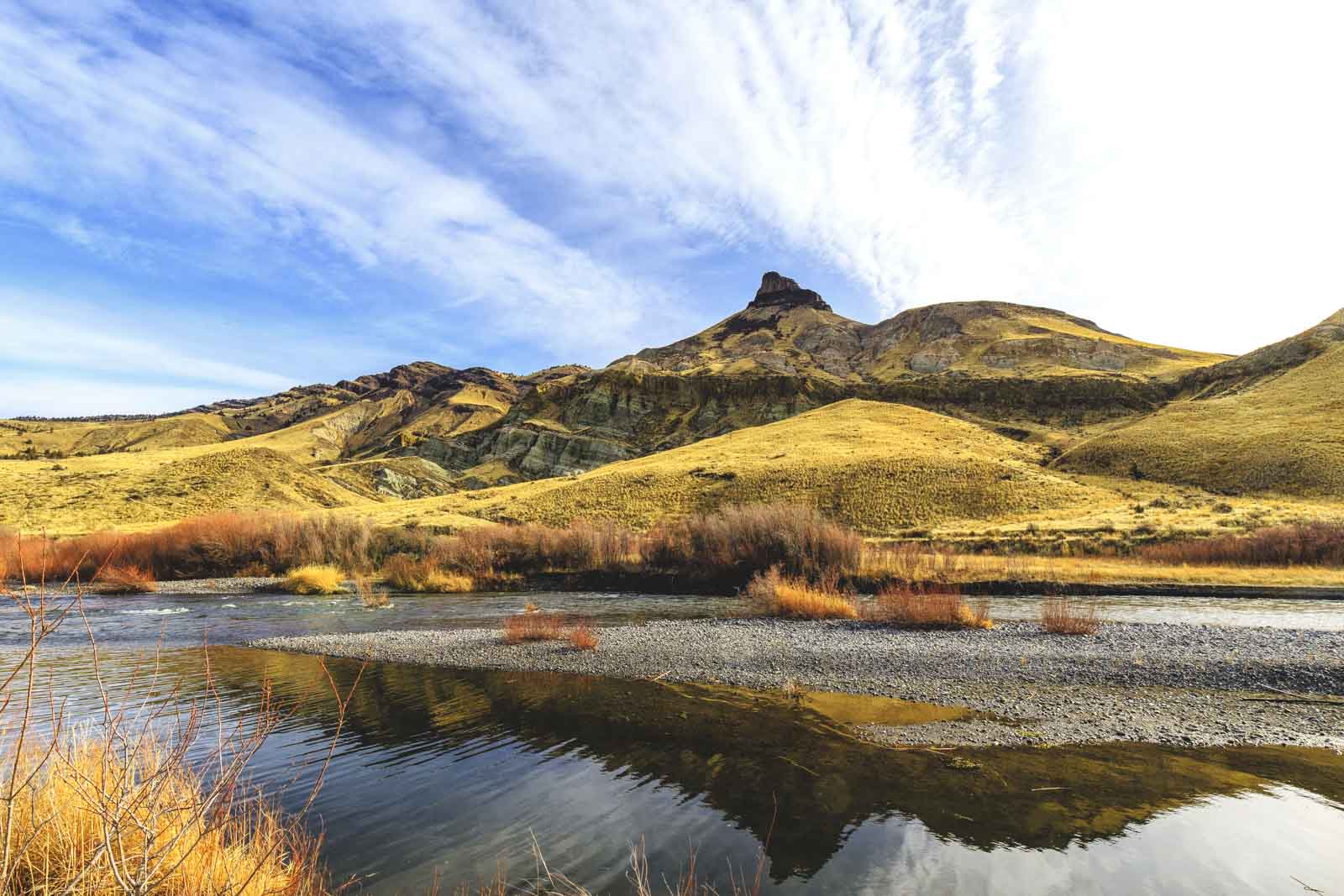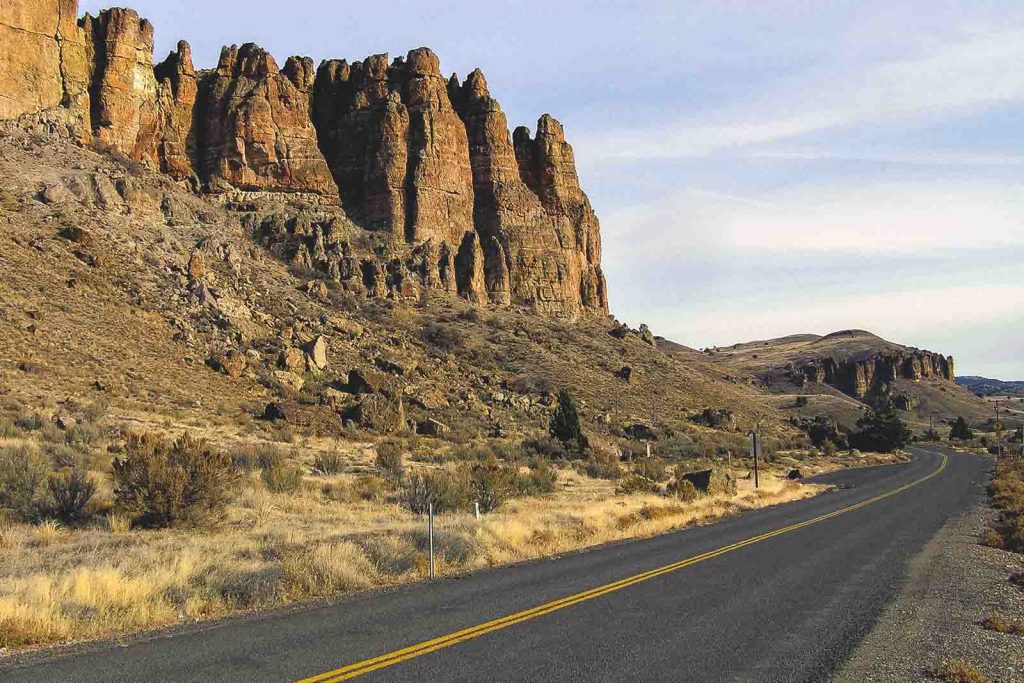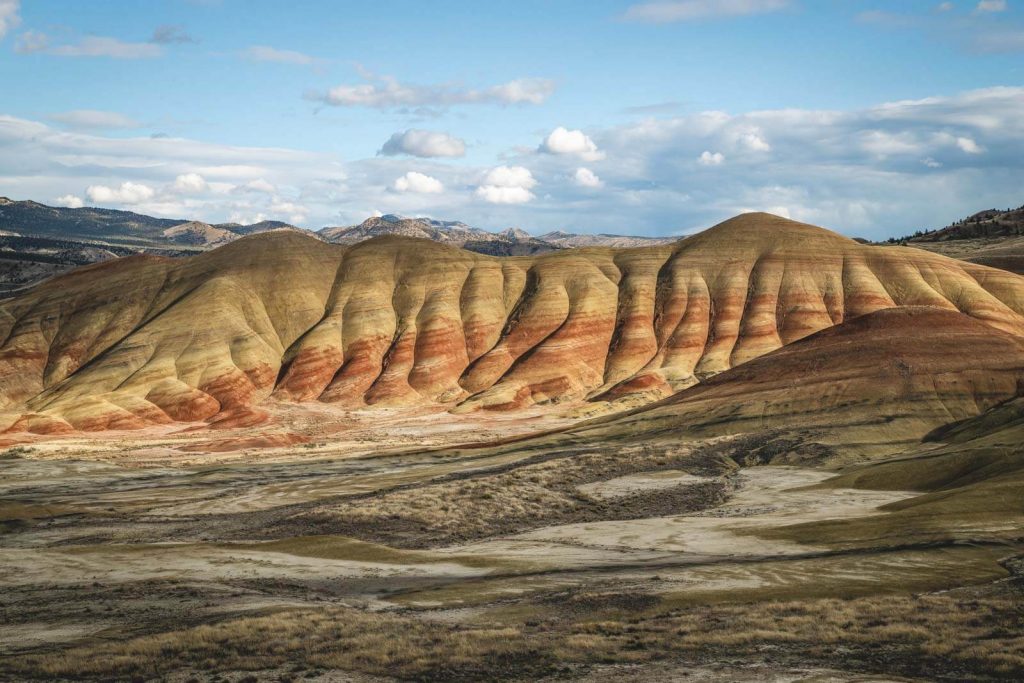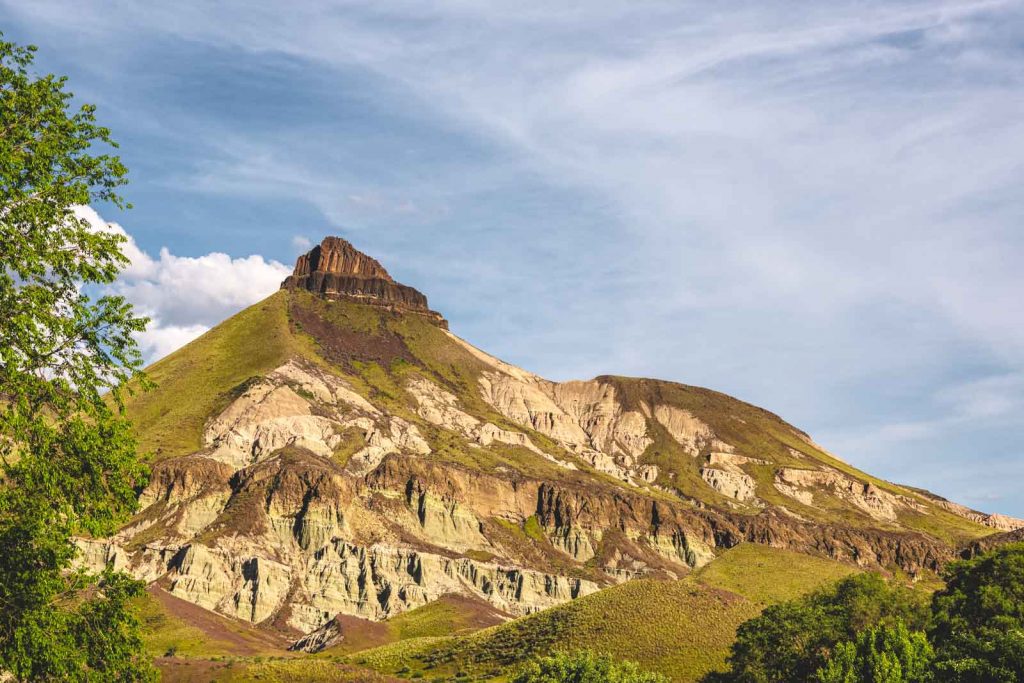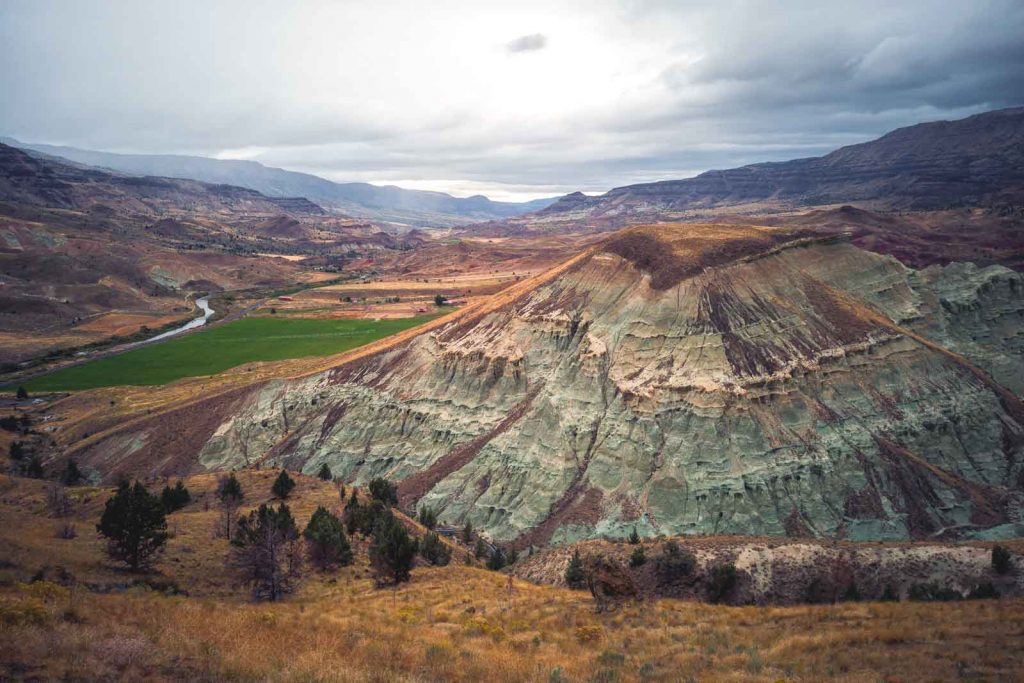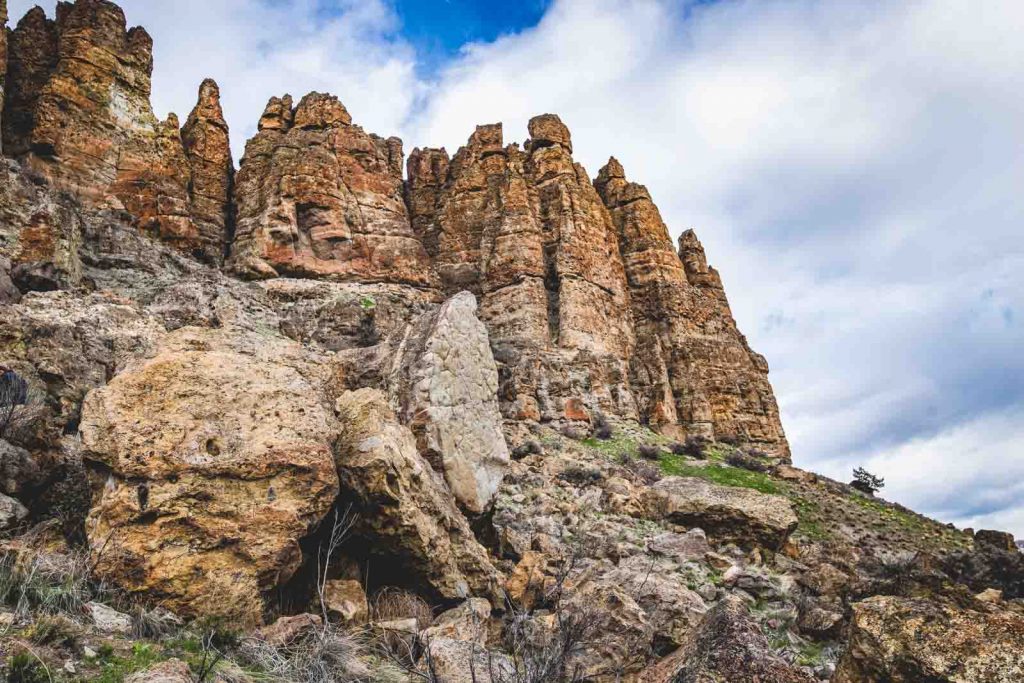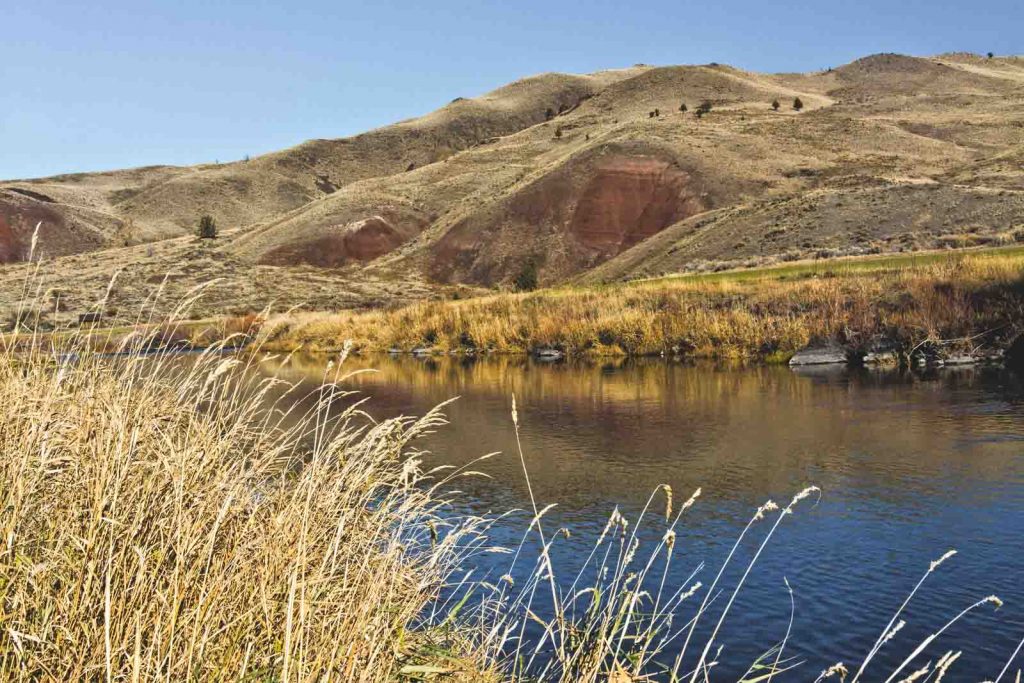The John Day Fossil Beds in Oregon—Painted Hills, Sheep Rock & Clarno
Just 1.5 hours from the city of Bend, tucked away in Eastern Oregon, is the John Day Fossil Beds National Monument. This site has made it onto Oregon’s 7 Wonders list, and as soon as you catch your first glance of the red hills, bizarre rock formations, and stunning peaks, you’ll immediately see why.
The Painted Hills are the most popular of the three units here, but all are worth a visit.
GET THE ULTIMATE PNW MAP
Get our curated list of the best adventures, things to do, and places to grab a brew loaded onto your maps with just two clicks!


Table of Contents
What Are the John Day Fossil Beds?
As soon as you see the John Day Fossil Beds, a US National Monument, you’ll be greeted with a stunning landscape of badlands made up of colorful rocks and uniquely eroded pinnacles. Located in Central Oregon, the John Day River cuts its way through the rock.
This area of the state is known for its incredibly preserved layers of fossil plants and mammals that lived in the region from about 45 million years ago, to about 5 million years ago. More than 100 species of mammals have been identified in the fossil beds here, from saber tooth tigers to salamanders.
Covering 13,944 acres, there is plenty to explore, but to make it easier, the monument consists of three geographically separate units, Sheep Rock, Painted Hills, and Clarno. Despite all being part of the same monument, there is a fair amount of semi-desert ranchland separating them, making visiting them all in one day quite tricky.
From Sheep Rock to Painted Hills is 45 miles, from here to Carno Unit is 75 miles, and then back to Sheep Rock is a further 81 miles. Each of the units is wildly different from the others, yet all offer stunning scenery, hiking trails, and interpretive displays.
The Painted Hills Unit in The John Day Fossil Beds National Monument
With gorgeous bands of reds and gold rippling across rolling hills, it is not really surprising that the Painted Hills is the favorite unit in the John Day Fossil Beds. They look as though they have been stained by the sunset, with colors changing with the time of day. These banded striations correspond to various geological eras that were formed when the area was an ancient river floodplain.
The colors were formed over 35 million years ago by different layers of volcanic ash. Each layer contained different minerals that compacted and solidified into the various bands.
Millions of years of history are revealed in the layers of earth, one color at a time. On your visit, you’ll see vibrant hues of orange, black, tans, and red that ‘paint’ the hills in a series of stripes. The rock also contains many fossils of leaves from 30 to 39 million years ago.
The best time to visit is after rain, as this is when the colors are the most intense. No matter when you visit, however, you will be impressed with the sight. It is open year-round, with small yellow flowers appearing in the spring and a sprinkling of snow in the winter.
For photography, the lighting is best in the afternoon, drawing in visitors from miles around to get a shot of the golden hills. The windswept typography has sculpted smooth curves into the multicolored rock, which helps to add to the area’s beauty.
This unit covers 3132 acres, meaning you should be able to see this unit all in one day. There are five main hikes in this unit, each of which is relatively short with their parking area. These include the Overlook Trail, the Carroll Rim Trail, the Red Scar Knoll Trail, the Painted Cove Trail, and the Leaf Hill Trail.
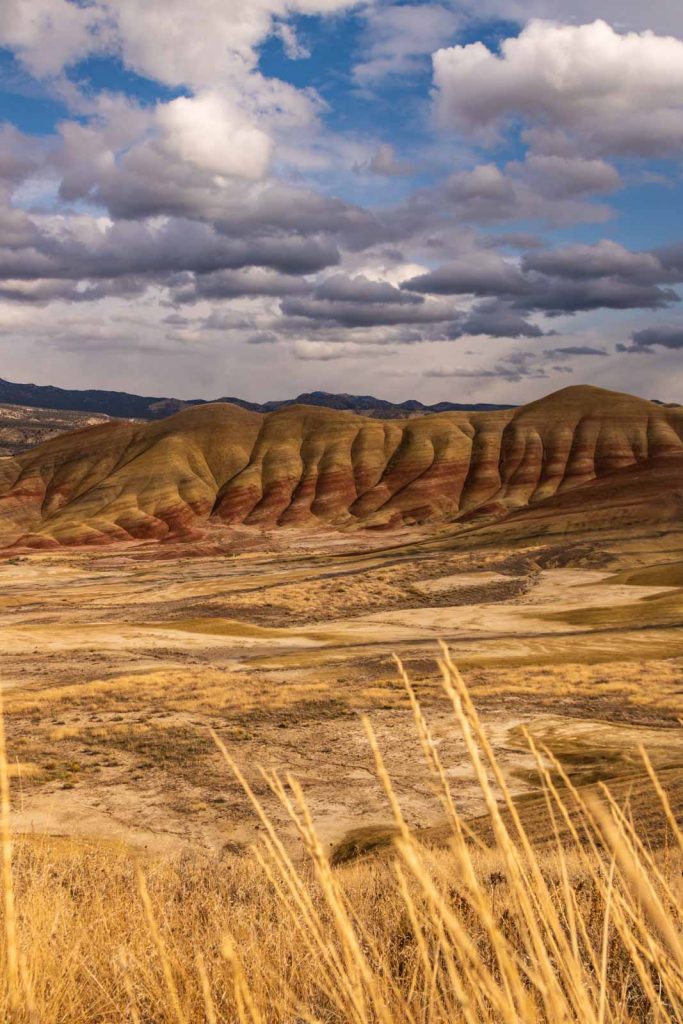
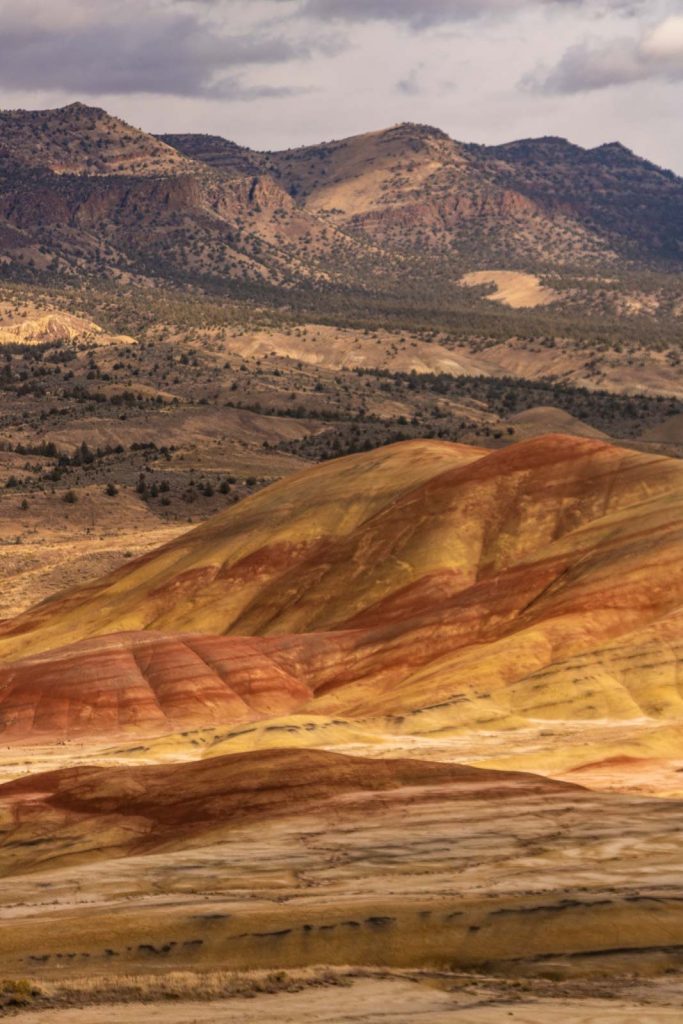
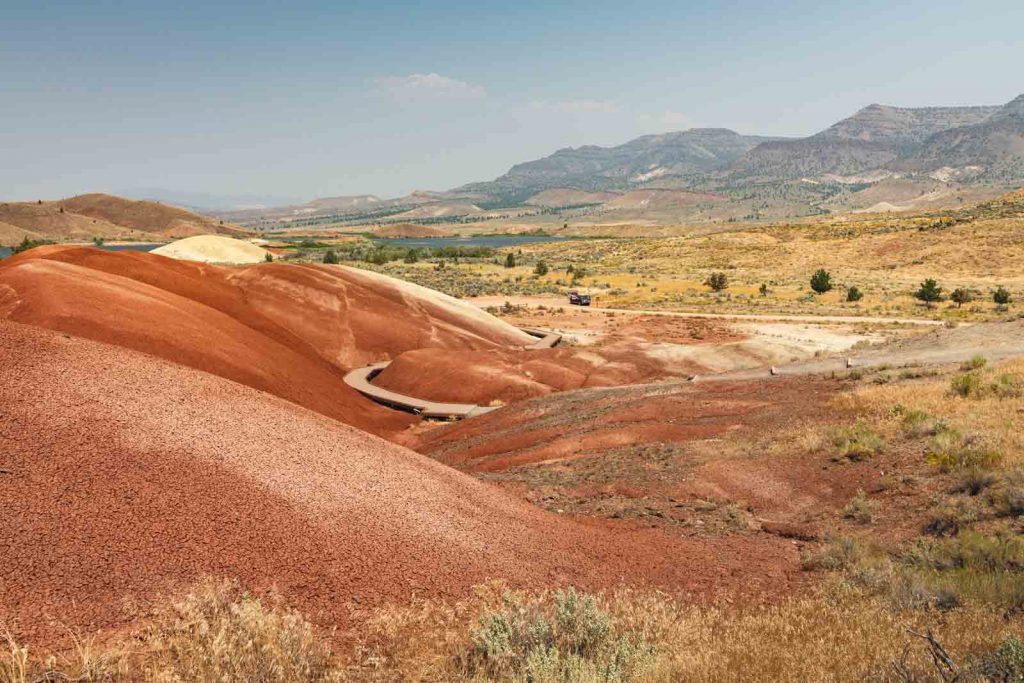
Carroll Rim Trail is the longest at 1.6 miles, but all are easily achievable and will reward you with stunning views and plenty of opportunities for photos. There are also well-maintained picnic areas and parking places, as well as informative signs to help you learn more about the area.
We actually have an entire guide on The Painted Hills, so let’s talk about the other two units!
Sheep Rock Unit in The John Day Fossil Beds National Monument
The Sheep Rock part of the monument is located to the east and is made up of a rocky terrain of complex geology. Although you may not see many today, the unit was named after the hundreds of wild bighorn sheep that used to live on the rocks.
The geological features in this part of the park are a spectacle to behold, with the blue and green hues coming from the layers of volcanic ash and chemical weathering.
This unit could be described as being the hub of monument operations, as it is here the monument’s headquarters and the main visitor’s center is located.
Hikes at Sheep Rock Unit
Overall, there are eight trails in this part of the monument, ranging in length from 0.25 miles to 3.25 miles.
Blue Basin Overlook Trail – 3.25-mile loop, medium difficulty – This is one of the best hikes in Sheep Rock and arguably in all of Oregon. As just over a 3-mile loop, it is easily achievable for hikers of most abilities, with an elevation gain of 600 feet.
There is a dedicated parking lot at the start of the trail, and from here, it will take you up through the fossil beds, up to the rim of the blue basin. Expect the view of the valley below to take your breath away.
Island in Time Trail – 1.3 mile round trip, easy – If you don’t have time fo the Blue Basin Overlook, or are just looking for something a little shorter, from the same parking lot you could also opt for the shorter Island in Time Trail.
By following the short gravel path, you’ll soon reach an amphitheater that has been carved out of the blue and greenstone. For those interested in the fossils, this is a good option, as interpretive signs and fossil replicas are dotted along the trail.
Flood of Fire – 0.4 mile round trip, easy – The Flood of Fire Trail starts at the Foree Trailhead. After a short climb, you’ll reach a viewpoint that overlooks the valley as well as a beautifully colored rock formation.
Story in Stone – 0.3 mile round trip, easy – Heading around a small basin, this level and the partially paved trail is suitable for beginners, as it also only covers a distance of 0.3 miles. The rocks here contain fossils of creatures that lived here between 25 to 30 million years ago.
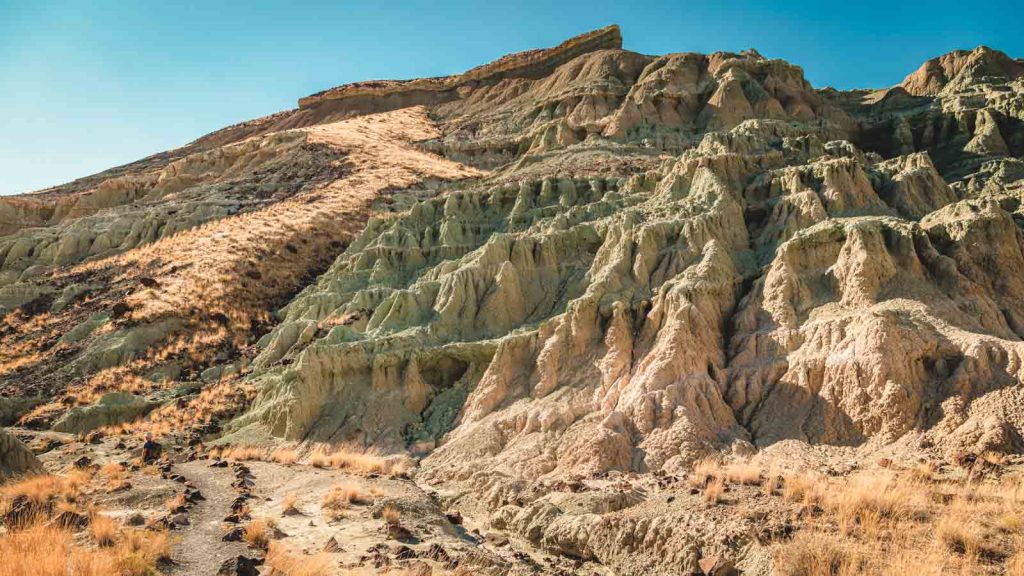
River Trail – 0.6 mile round trip, easy – The River Trail is made up of packed gravel, and it mostly level, making it a straightforward hike. As the name suggests, it will take you right up to the John Day River from the Cant Ranch Parking lot, with scenic views along the way.
Sheep Rock Overlook Trail – 0.5 miles round trip, easy – A short round trip that starts at the front of the Cant House. The reward at the end of this trail is a beautiful overlook of the river and valley stretching out below you.
Thomas Condon Paleontology – 0.25 mile round trip, easy – After learning more about the area in the visitors’ center, take this short overlook trail to take in a great view of the valley. You can start this short walk at the south end of the parking lot.
READ MORE: 37 of the Best Oregon Hikes You’ve Got to Check Out
Things to Do at Sheep Rock Unit
Thomas Condon Paleontology Center – This fascinating center is well worth a visit when in Sheep Rock, as it will help give you a little more info about your surroundings in an exciting way.
Expect to see some amazing fossils, interpretive programs, fossil presentations, and even a viewing window into the fossil laboratory, where you will see the area’s paleontologists doing what they do best. It is here you will be able to find out about some of the best hiking trails and things to do.
Picture Gorge – This is an excellent drive-through attraction, located on either side of the entrance to the Sheep Rock Unit. The cliffs on either side of the road rise in stunning shades of purple, red and brown, with plenty of pull-outs for those that want to stop and take it all in.
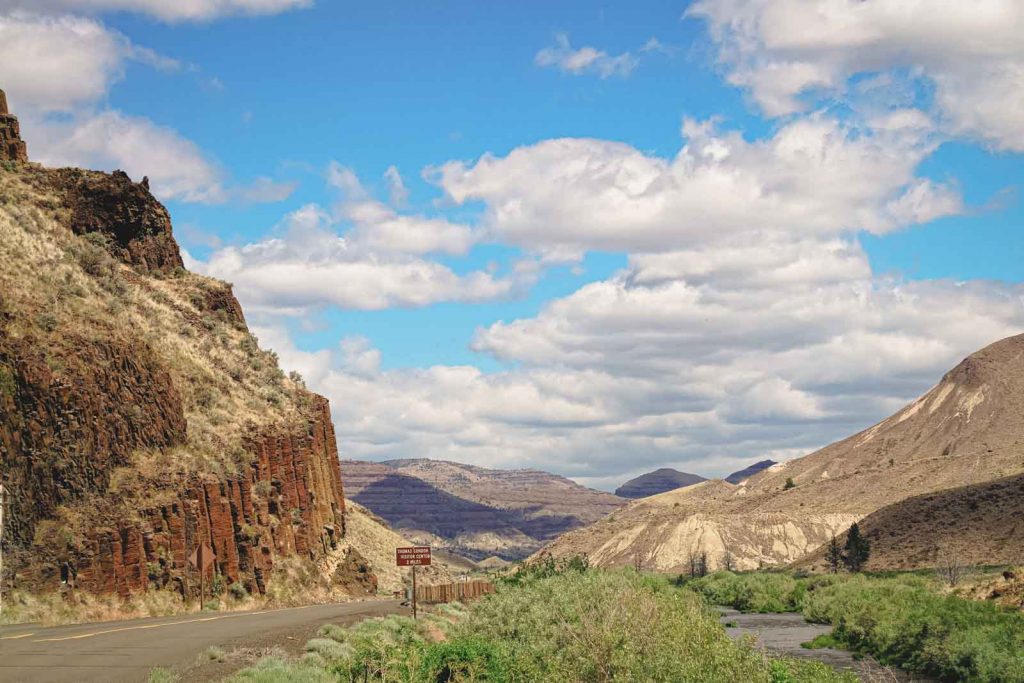
James Cant Ranch House – In 1984, the house and outbuildings were listed on the National Register of Historic Places, and in 1975, when the monument opened, it served as the headquarters for all three of the units. Today, the lower floor is open to the public as a small museum, home to a range of exhibits about the history and culture of the region.
Mascall Overlook – Don’t miss the sweeping views of the John Day Valley from the Mascall Overlook, at a height of 150 feet, Picture Gorge can also be spotted.
Clarno Unit in The John Day Fossil Beds National Monument
This remote corner of the desert is home to some of the oldest fossils in the region. When you enter this region, the most prominent landmarks you’ll spot are the towering Palisades of dark rock that reach up to the sky.
These towers of rock are volcanic lahars or mudflows that formed 54-40 million years ago. It is hard to believe it when you look at the stark landscape, but the area was once covered in lush, semi-tropical rainforest, the proof of which is in the fossils.
As well as a diverse range of plant life, other fossils of creatures such as tiny four-toed horses, meat-eating creodonts, and other strange beings have also been found here.
Hikes:
Three hikes can be found at the Clarno Unit, two of which start at the Palisades Trailhead, and the Time Trail connects the trailhead with the picnic area. There is limited parking at the trailhead, but additional parking can be found in the picnic area.
Trail of Fossils – 0.25 mile loop, easy – Get up close to some of the most incredible fossils in the unit, most of which are plant life like palms, logs, magnolia leaves, seeds, and nuts, all of which are embedded in the rock faces, a stark reminder of when the area was once covered in forest.
The trail is backed with chalk-white cliffs, which are characterized by stone spires reaching into the sky. This is the only trail in the park where you can see fossils in the rocks and large boulders that scatter the ground.
Clarno Arch Trail – 0.25 mile round trip, medium difficulty – As the name suggests, at the end of this trail, you’ll be rewarded with sights of an unusual stone arch. More unusually, at the end of the trail is also the bottom of a fossilized log. The steep climb of 200 feet to the base of the palisades is worth it for a close up look at these cool sites.
Geological Time Trail – 0.5 mile there and back, easy – Take a walk through history with the Geological Time Trail, where you can learn more about the geological past of the area through a series of interpretive signs. Each foot of the trail has been designed to represent 37,000 years. At the end of the trail, you’ll find a beautiful little picnic area.
Camping Options in the Area
Although there are no camping facilities directly in the monument, there are plenty of options nearby.
Ochoco Divide Campground – Set in a beautiful ponderosa pine forest is the Ochoco Divide Campground, located at the summit of Ochoco Pass, close to the Painted Hills Unit. There are 28 campsites here, which are open between May and November.
Cottonwood Campground – For a more primitive camping experience, Cottonwood Campground is a good option. It is very rustic and only offers seven campsites, surrounded by aspen and conifer forests. Sites are open year-round and are offered at a first-come, first-served basis. The small pond provides a great place to cool off in the summer months, and there are picnic tables, toilets, and parking.
Lands Inn – Just to the north of the monument is Lands Inn Cabins and Camp Sites, offering the options to either stay in one of the rustic cabins or your tent or trailer. There is no cell service or evening lights, meaning you can spend your evenings relaxed and without life’s daily distractions. All electricity is solar-powered, and facilities include showers, toilets, and an outside sink.
Red Hill Dispersed Camping – As it is Bureau of Land Management Land, camping here is free of charge. You can camp right up on the banks of the John Day River, and usually doesn’t get too crowded.
Wheeler County Fairgrounds RV Park – Located near the town of Fossil by the Clarno Unit, these campgrounds are very clean and offer full hook-up RV sites. As it is located by the town, there are plenty of places to stock up on groceries.
READ MORE: 29 Awesome Things to Do on an Eastern Oregon Road Trip
Tips for Visiting The John Day Fossil Beds National Monument
- There is no charge for visiting the fossil beds, making it a very cheap trip to see some incredible features.
- Bear in mind that everything within the site is protected, meaning that all archeological features, fossils, rocks, and plants can’t be disturbed.
- Most of the tiny towns within the fossil beds don’t have much in the way of amenities, so it may be best to stock up on things like food and gas before you head in, as well as lots of drinking water.
- If you are thinking of bringing your furry friend, they must be kept on a leash at all times.
- As the colors of the hills look better in the late afternoon, it is best to plan your trip to which area you want to be in at which part of the day.
- The units are open throughout the whole year, but potable water is only available at the picnic areas between spring to fall. The summers here can get very hot, so sunscreen is essential.
- All three units have a picnic area, so bring a packed lunch.
- To visit all three units at the John Day Fossil Beds you’d really need three days. Sheep Rock has the most hikes to conquer, Clarno would be the quickest to see, and the Painted Hills are going to be the most crowded if you’re here at peak season. Don’t forget the amount of time it takes to drive between the three as well. Plan accordingly.
- Don’t forget our guide on The Painted Hills for more info on that area.
We hope this post helped you plan a fun trip to the John Day Fossil Beds! Check out more of what eastern Oregon has to offer and other fun adventures in Oregon.

